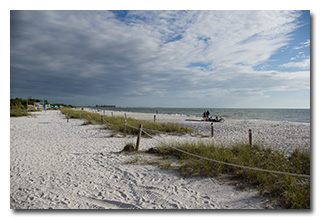
by William Eric McFadden
Seven Days in Florida Sunshine!
From the park website:
-
In the early 1900s the islands were accessible only by boat. It was said that only lovers made the effort to get to this romantic island, thus the name Lovers Key. A road to the island was built in 1965. Local legend hints that Black Island got its name from Black Augustus, a pirate who had been captured by authorities, and later escaped, making this island his home for the remainder of his life. Fish camps were located on Black Island from the early 1900s until the late 1950s.
In the 1960s and 1970s, the four barrier islands were slated for development. Preparations for development damaged the islands. Mangrove swamps were altered to uplands by dredging a canal through Black Island.
In 1983, the state acquired the islands and in 1996, merged with adjacent Carl E. Johnson County Park to become Lovers Key Carl E. Johnson State Park.
Pictures
Description
 One member of the Southeast Ohio Radio Adventure Team succeeded in
performing a valid activation on November 13, 2018 of Lovers Key State Park, K-1900, in Florida as
part of the the Parks on the Air (POTA; link) program. Eric
McFadden, WD8RIF, visited the park on a lovely weekday afternoon and was accompanied by his wife Vickie,
KC8MAJ, and his sister-in-law, Jan, who explored the beach and hunted for seashells while Eric performed his
activation.
One member of the Southeast Ohio Radio Adventure Team succeeded in
performing a valid activation on November 13, 2018 of Lovers Key State Park, K-1900, in Florida as
part of the the Parks on the Air (POTA; link) program. Eric
McFadden, WD8RIF, visited the park on a lovely weekday afternoon and was accompanied by his wife Vickie,
KC8MAJ, and his sister-in-law, Jan, who explored the beach and hunted for seashells while Eric performed his
activation.
The trio arrived at the park about 1940 UTC and took the tram to the beach on Lovers Key Island. Eric chose to set up his station in the beach's gazebo in order to avoid sitting in too much direct Florida Sun. Eric's station consisted of his Enhanced KX3 Travel Kit and an N2CX-inspired 20/30/40m wire vertical supported on a Black Widow 20' telescoping pole and fed through 25' of RG-58 coax. Eric was on the air by 2011 UTC.
Eric began operations on 20m and, thanks to excellent spotting by fellow-RAT K8RAT, managed fourteen QSOs in just about twenty minutes. Eric switched to 40m and discovered that, as at Koreshan State Historic Site, his triband vertical didn't provide a good match on that band and he was forced to use the KX3's internal ATU to tame the high SWR. Eric made three QSOs on 40m in about fifteen minutes.
Eric was pleased to again work his friend K8RAT and fellow POTA participants N8XX and VE3ZN.
While waiting for the tram to the beach prior to the activation, Eric, Vickie, and Jan saw a pair of osprey nesting on a light above the tram station. However, the ospreys had flown off after the activation, when Eric had his camera ready, so no photos were made.
Eric also submitted his log to the World Wide Flora and Fauna in Amateur Radio (WWFF; link) program although his seventeen QSOs were not sufficient to achieve a valid activation within the program which requires 44 QSOs be made.
All Eric's QSOs were made at the 5-watt level.
(return)